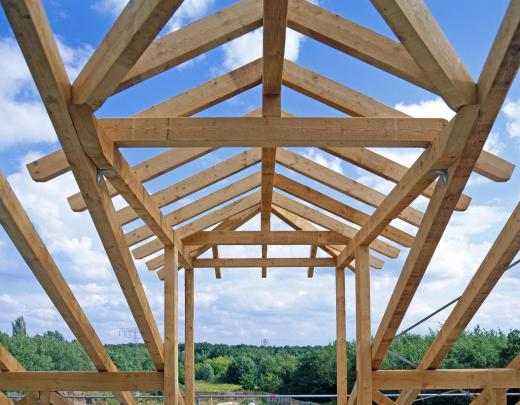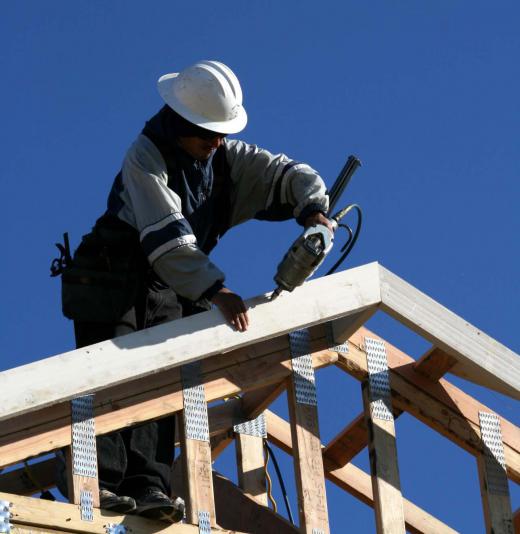What are the Different Types of Truss Construction?
In construction, truss structures are commonly used for roofs and floors. There are a variety of different forms of truss construction, each with its advantages and disadvantages. Truss design choices are based on aesthetic and structural needs, although if there is an existing structure to be remodeled, choices may be limited. Architectural consultation can help homeowners make sound decisions on truss engineering choices.
Trusses are composed of one or more triangles connected to support beams. This truss construction provides structural integrity, as the strength of the sides of triangles does not fluctuate under pressure. Conversely, four-sided figures, such as squares or rectangles, require extra bracing to guarantee stability.

Variations on styles of trusses are almost endless; if the mind can picture a truss construction design, there is probably an architect who can create it. The two most common truss designs, however, are the pitched or common style and the parallel chord or flat truss. The pitched truss is a triangular form used mainly for roofs. The parallel chord truss has two parallel outside braces, or chords, sustained by squares supported by four connected triangles inside each square. These trusses are used for floors.

Many of the more elaborate types of truss construction are based on these two styles. Each type of truss design is intended to fulfill precise structural and aesthetic objectives. Both these considerations are required in choosing the best type of truss to use for each project's shape, size, and design demands.
Floor trusses are built with strength and practicality as major considerations, while roof trusses often concentrate on cosmetic appeal. In roof trusses, climate is also a major consideration, as each type of truss provides different levels of insulation and air-vapor obstruction. The four most common roof truss designs are raised heel, dropped chord, scissor, and parallel chord. Personal preference, budget, and the overall design of the structure dictate which style is preferred.
A raised heel truss provides the best energy efficiency as its design allows ample space for maximum insulation. It creates a vapor barrier, which prevents potentially damaging moisture condensation, dry rot, and mold. The expensive manufacturing costs coupled with the need for insulation and installation materials make this a higher priced option.
Much like a raised heel truss, a dropped chord truss is airtight and allows room for deep insulation. This design utilizes taller studs and requires siding where the ceilings and walls are joined together. It is often the preferred option if an interior ceiling is unstable, although the extra siding and insulation add to the cost.
Cathedral ceilings often require a scissor truss, which has a design that resembles a hang glider. The shape eliminates the need for a supportive bearing beam and wall. This truss makes insulating the attic a more difficult task and increases labor costs.
A parallel chord truss is also a popular choice for structures with cathedral ceilings and makes insulation of the attic easier than other truss styles. It does require specially designed steel and wood supports, which increase its cost. The thermal effects of the steel braces can also adversely affect energy efficiency.
AS FEATURED ON:
AS FEATURED ON:












Discuss this Article
Post your comments